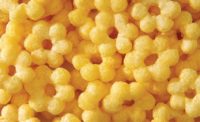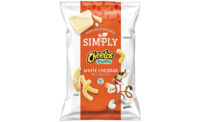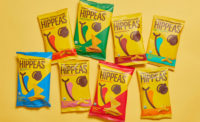The versatile puffed and extruded snack segment is answering the call of consumers who want to try different flavor profiles and combinations. On the traditional side, products such as Cheetos continue to prosper in the marketplace. In fact, total annual sales for cheese snacks just reached $2.1 billion. Through a balance of tradition and forward-thinking innovation, this segment represents the best of both worlds.
Overview | Chips | Puffed/Extruded Snacks | Popcorn | Snack Mixes & Nuts | Tortilla Chips | Pretzels | Frozen Snacks | Crackers
The market shows a trend toward healthy, organic and gluten-free puffed and extruded snacks. Better-for-you options, such as puffed/popped ancient grains, are building steam. Other key trends involve inclusion of higher protein and fiber levels, snacks featuring pulse ingredients, and unique textures that give the consumer a better eating experience.
“It really is an opportunistic market, as we have moved from a more-limited scope of ingredients used in snack foods to basically having no limit of pairings of flavors,” says Tara Froemming, marketing coordinator, Healthy Food Ingredients, Fargo, ND.
Market data
According to data from IRI, Chicago, extruded snacks had a great year. Cheese snacks was up 7.61 percent in dollar sales for the 52 weeks ending April 16, 2017, garnering $2.1 billion in sales. PepsiCo subsidiary Frito-Lay was up 8.98 percent in dollar sales to $1.8 billion thanks to strong sales from its segment-dominating Cheetos products. Utz Quality Foods saw its cheese snacks grow by 12.42 percent in dollar sales for the year to $61.1 million, and private label cheese snacks grew by 15.20 percent to $53.4 million.
Frito-Lay Cheetos are the flagship of cheese snacks and saw dollar sales growth of 8.96 percent to $1.6 billion. Its “natural” counterpart, Cheetos Simply Cheese, grew 26.38 percent to $36.3 million. Frito-Lay also owns the No. 2 cheese snack brand, Chester’s, which was up 9.26 percent in dollar sales to $117.5 million. Utz Quality Foods saw its Utz brand of cheese snacks grow by 12.75 percent in dollar sales for the year, taking in $54.6 million.
An emerging product type within cheese snacks offers consumers the ultimate approach toward clean-label simplicity. Cello Whisps from Schuman Cheese, which were up 124 percent in dollar sales for the year, hitting $2.8 million, are made with one ingredient—cheese. Parmesan Cello Whisps have been on the market for a couple of years now, and a Cheddar variety was introduced in 2016. This year, Schuman Cheese expanded the line to include Asiago and Pepper Jack Cello Whisps. The cheese snacks are baked to a crispy, crunchy texture. The single-ingredient better-for-you clout of Cello Whisps is nicely complemented with naturally high levels of calcium and protein in the products.
Other similar products are competing within this market. Moon Cheese from NutraDried are small, round cheese snacks that likewise are made with 100 percent real cheese. Flavors include Cheddar, Gouda and Pepper Jack.
The “other salted snacks (no nuts)” segment of the salty snacks category, which includes a good level of puffed and extruded snacks, saw growth of 4.45 percent in dollar sales to $4.0 billion. The Funyuns brand from Frito-Lay saw dollar sales grow by 4.00 percent to $361.4 million; the line now includes flavors like Flamin’ Hot, Chile Limón and Steakhouse Onion. Chester’s also has products grouped into other salted snacks, and they were up 13.56 percent to $259.5 million. Another strong-performing product line was the Garden Veggie Straws from Hain Celestial brand Sensible Portions, up 18.74 percent to $83.8 million.
Corn snacks likewise saw growth, up 3.92 percent to $1.2 billion. The Fritos brand rules this segment, up 6.27 percent to $508.2 million, per IRI. Fritos Scoops sits at No. 2 in the segment, up 0.47 percent to $226.1 million. A newcomer to the segment is the Mondelez International Ritz brand with its Toasted Corn Chips, available in Original and Salsa Verde. Introduced in early 2016, the brand saw sales of $7.1 million for the 52 weeks ending April 17, 2017.
Pork rinds also had a good year, growing 4.9 percent in dollar sales to reach $417.8 million. While category leader Frito-Lay and its Baken Ets brand saw a slight dip of 2.98 percent to $124.1 million, others saw gains. Sales for the No. 2 brand in the segment, Mac’s Snacks Pork Rinds, increased 41.6 percent to $53.3 million.
The Paleo movement has helped bring pork rinds to a new audience. The new line from 4505 Chicharrones has “Paleo Certified” products in the lineup in flavors like Smokehouse BBQ, Chili & Salt and Jalapeño Cheddar.
Looking back
Ancient grains, such as sorghum, millet or chia, are adding appeal to brands in this snack category, says Mark Stavro, senior director of marketing, Bunge North America, St. Louis. “In addition to offering ready-to-eat puffed and extruded snacks, puffed grains are an attractive addition when used as an inclusion in a snack food or baked good.
“Puffs and extrusions can be coated with agave, a dark chocolate drizzle and sea salt, or a savory seasoning blend combination for an indulgent snack with a health halo,” Stavro continues. “Ancient grains used in current extrusion formats—curls, puffs, balls, sticks—can help bring new, trending ingredients to the market without sacrificing taste and the texture consumers expect.”
Many brand owners are looking to include plant-based proteins in their puffed and extruded snacks, according to Gunther M. Brinkman, vice president, contract manufacturing, Ideal Snacks Corp., Liberty, NY. “Pulses and peas are popular, and we are doing some R&D work with marine-based (algal) proteins. Ancient grains continue to be of great interest, both for their nutritional content and as a signal that the product is not overly processed.”
In March 2017, Peeled Snacks released a line of Baked Organic Pea Puffs that tout “1/2 cup of vegetables per serving” on front-of-pack messaging. They also offer 4 grams of protein per serving.
More puffed and extruded snacks are featuring clean labels with nutritional value, according to Paul Nardone, CEO, Our Little Rebellion, Liberty, NY. “For years, puffed and extruded snacks lacked in nutrition, but met consumer demand for flavor and texture. I think this category, which is expected to reach $31 billion by 2019, will continue to see more use of alternative ingredients such as ancient grains and modern twists to traditional sweet and savory flavor profiles.”
Our Little Rebellion Protein Crisps, in flavors like Wasabi Ginger with Honey, Hot Buffalo and Sweet & Smokey BBQ, hit the market in March 2017 and have 10 grams of plant-based protein per serving.
Another on-trend example that hit store shelves within the past year is the White Cheddar Puffs from the Cape Cod brand, owned by Snyder’s-Lance, a Non-GMO Project Verified cheese snack made without preservatives, artificial colors or artificial flavors.
Healthy Food Ingredients offers non-traditional ingredients to the puffed and extruded segment, working with product developers to recommend the best ingredient option for the intended application. The company offers grains, beans and seeds in different ingredient formats like whole, flakes and flour. “For example, if the developer wants to utilize a gluten-free lentil into a snack application, we might recommend a precooked lentil flake that will easily work with the other ingredients in that particular application,” says Froemming.
Extrusion technologies are rapidly developing, which gives snack food developers more tools to test new concepts. “Our laboratory extruders allow for the investigation of raw materials, and the interaction of such raw materials, on a micro level. They facilitate manageable sample size to upscale toward production-like parameters,” says Sal Iaquez, vice president, sales and marketing, Food Division, C.W. Brabender Instruments Inc., South Hackensack, NJ.
Extruder versatility is a crucial area of innovation, says Kyle Stuart, culinary scientist, Parker Products Inc., Fort Worth, TX. “Easily interchangeable dies and adaptability is what allows companies to keep up with new ingredients and trends. Post-extrusion processing also is popular and can be used to create crisp textures in a variety of shapes and sizes.”
Sophisticated extrusion technology helps make intricately three-dimensional products like the new Lay’s Poppables a reality, building consumer interest.
The broad ingredient versatility provided by the use of twin-screw extrusion is allowing the expansion of value-added snacks with additional unique ingredients that was not possible with single-screw snack extruders, according to Jonathan Baner, senior technical manager of extrusion, PacMoore Products Inc., Hammond IN.
Baner believes that protein fortification is the most-prominent trend in new product development. “Consumers continue to seek alternative snacks with better nutrition profiles and enhanced fiber and protein content. Calorically dense snacks command a better margin for companies, because consumers are willing to pay more for products that they perceive to have increased value and nutrition.”
Sanitation and validation are top requirements for extrusion equipment today. Along with offering high production rates, the equipment must be safe to operate, easy to clean and sanitize. “We are working with customers to achieve this goal,” says Eugene Dust, senior extrusion technologist, Buhler Inc., Minneapolis. “Our production-size extruders not only minimize flat areas and corners where materials may build up, but we have introduced a push-out device to facilitate changeover and cleaning between runs.”
Clextral Inc., Tampa, FL, recently introduced the Evolum+ twin-screw extruder, a high-throughput machine with optimized thermal control that provides maximum production stability, according to Hadrien Delamazure, pilot plant manager. “Its hygienic design makes it easy-to-clean. Also, Clextral offers a range of ancillary equipment for further processing. One example is our coating system with integrated CIP (Clean in Place),” he says.
Looking forward
Dust believes that textures and flavors will continue to drive trends in this market segment. “Flavors will diversify,” he notes. “New flavors and seasonings, exotic combinations of these, and formulating the base crisp with new and ancient ingredients are some areas that are being explored. This will task extrusion technologists to provide shapes, textures and flavor control.”
The greatest opportunities for growth in puffed and extruded snacks are the inputs—the great variety of grains, vegetables and fruits that can be extruded and puffed—and the outputs, including the variety of formats and shapes that can be made, according to Stavro. “In addition, puffed and extruded snacks offer endless possibilities for creating customized flavors with limited-time seasonings and coatings.”
Nardone says the biggest opportunity for growth is the continuation of better-for-you ingredients. “We know through data tracking that consumers want clean, high-protein options across the board. That’s why we introduced Protein Crisps, which are packed with 10 grams of plant-based protein and only 80 to 90 calories and 10 carbohydrates per serving. It’s innovative ingredients and rich nutrition profiles that grab consumer attention.”
The trend toward using ancient grains will continue to build in North America, according to Stuart. “As consumers become more familiar with ancient grains such as quinoa, amaranth and sorghum from exposure in the restaurant industry, manufactured food companies will begin to experiment with these ingredients, as well.” Many of these companies are just now scratching the surface of endless possibilities, he adds.
Overview | Chips | Puffed/Extruded Snacks | Popcorn | Snack Mixes & Nuts | Tortilla Chips | Pretzels | Frozen Snacks | Crackers














